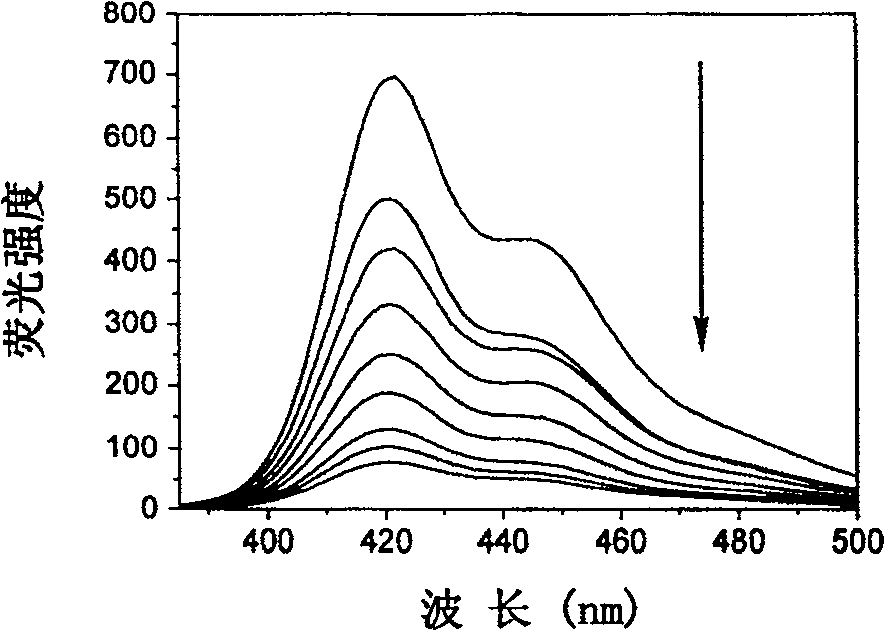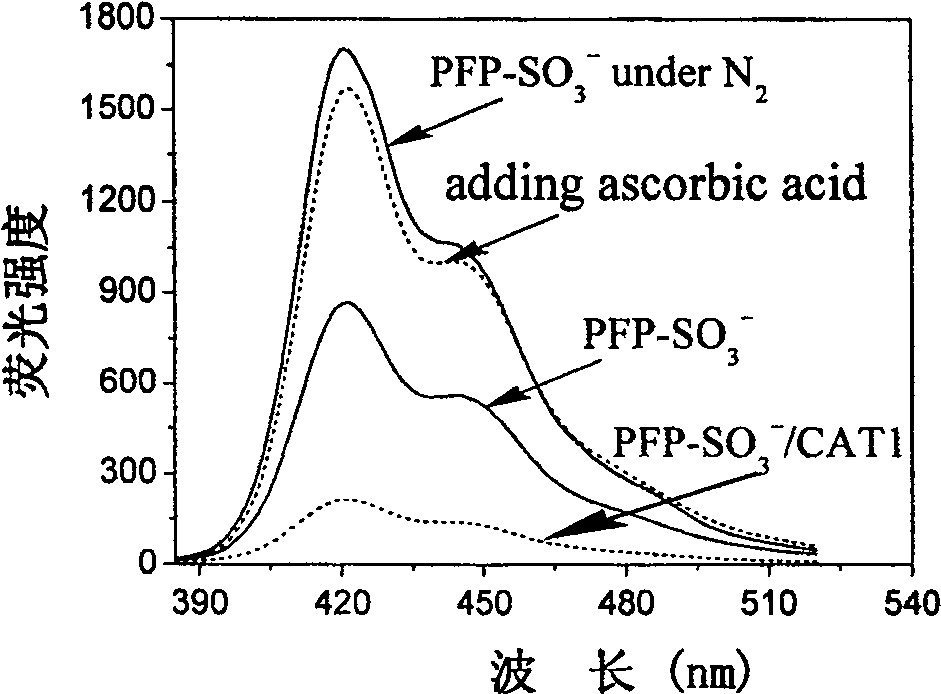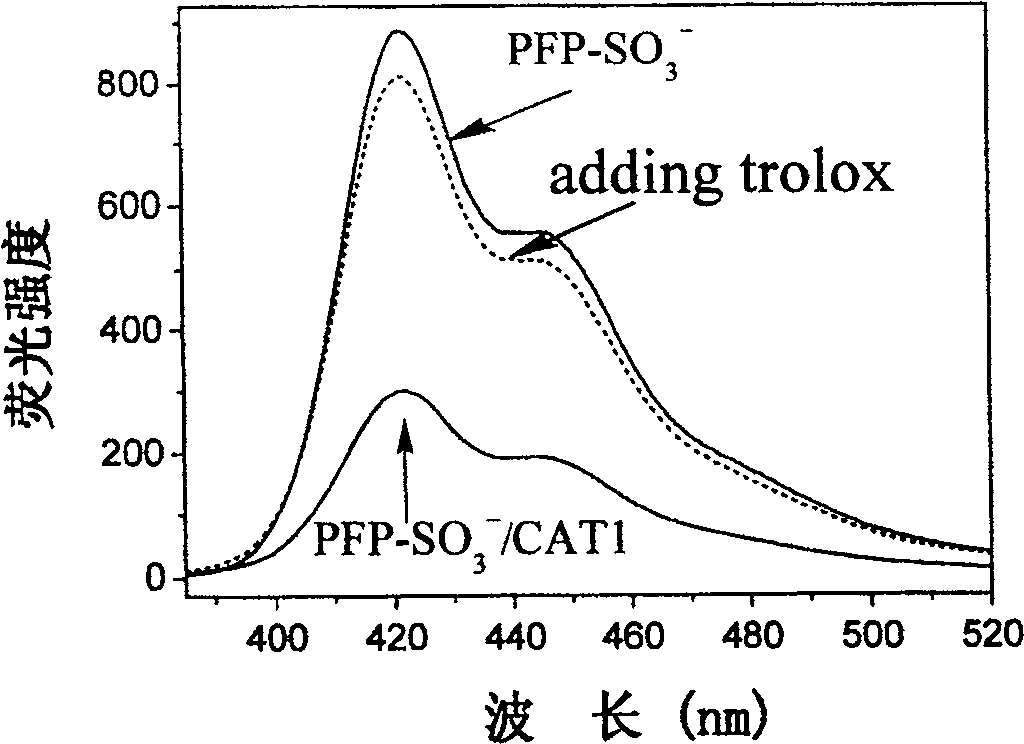Complexes used for detecting the reaction for cleaning free radical with anti-oxidants and detection method there of
An antioxidant and free radical technology, applied in chemical instruments and methods, fluorescence/phosphorescence, luminescent materials, etc., can solve problems such as difficult purification and preservation of samples, harsh synthesis conditions, and difficult synthesis
- Summary
- Abstract
- Description
- Claims
- Application Information
AI Technical Summary
Problems solved by technology
Method used
Image
Examples
Embodiment 1
[0036] Embodiment 1, preparation anionic conjugated polymer PFP-SO 3 - Complex I with cationic radical CAT1
[0037] In 2970uL of phosphate buffer solution with an ionic strength of 5mM, add 3uL of PFP-SO with a concentration of 1mM 3 - (Refer to literature: Burrows, H.D.; Lobo, V.M.M.; Pina, J.; Ramos, M.L.; de Melo, J.S.; Valente, A.J.M.; Tapia, M.J.; Pradhan, S.; -7427 synthesis, or direct purchase), and then add 1.0uL cationic radical quencher CAT1 with a concentration of 30uM, and mix well to obtain complex I with a molar ratio of 1:0.01.
[0038] The present invention uses ultraviolet spectrometer Jasco V-550 type, and fluorescence spectrometer is F-4500 type (Hitachi), is excitation light source with xenon lamp; Used fluorescent cell is the polystyrene fluorescent cell of 3mL, and excitation wavelength detects under the condition of 376nm , all experiments were carried out in phosphate buffer solution (5mM, pH 7.4), the water used was purified by Millipore filtratio...
Embodiment 2~12
[0039] Embodiment 2~12, preparation anionic conjugated polymer PFP-SO of the present invention 3 - Complexes II~XII with cationic radical CAT1
[0040] According to the preparation method and detection method of Example 1, a series of complexes of the present invention were prepared. The anionic conjugated polymer, the molar ratio with the cationic radical quencher, and the fluorescence intensity of the complex are listed in Table 1.
[0041] Table 1, composition and fluorescence intensity of complexes of the present invention
[0042]
Embodiment 13
[0043] Example 13, using the complex in Example 1 to detect the reaction of antioxidants to scavenge free radicals
[0044] 1) In 2970uL ionic strength of 5mM phosphate buffer, add 3uL concentration of 1mM anionic conjugated polymer PFP-SO in the complex of Example 1 3 - , under this concentration condition (1uM) PFP-SO 3 - The fluorescence intensity is 695;
[0045] 2) Then add the cationic radical quencher CAT1 in Example 1, the molar ratio of the added anionic conjugated polymer to the cationic radical quencher is 1:0.01; detect the fluorescence intensity of the formed complex 497( Such as figure 1 shown, the second curve from top to bottom);
[0046] 3) Add 1.5uL of 10uM ascorbic acid (antioxidant) to be tested, mix well and let stand at room temperature for 10 minutes, then detect the fluorescence intensity of the complex at 530 on a fluorometer; compare the change of the fluorescence intensity of the complex before and after adding ascorbic acid, It can be obtained...
PUM
| Property | Measurement | Unit |
|---|---|---|
| fluorescence lifetime | aaaaa | aaaaa |
| fluorescence | aaaaa | aaaaa |
| fluorescence | aaaaa | aaaaa |
Abstract
Description
Claims
Application Information
 Login to View More
Login to View More - R&D Engineer
- R&D Manager
- IP Professional
- Industry Leading Data Capabilities
- Powerful AI technology
- Patent DNA Extraction
Browse by: Latest US Patents, China's latest patents, Technical Efficacy Thesaurus, Application Domain, Technology Topic, Popular Technical Reports.
© 2024 PatSnap. All rights reserved.Legal|Privacy policy|Modern Slavery Act Transparency Statement|Sitemap|About US| Contact US: help@patsnap.com










